Navigating the Digital Neurolandscape: Analyzing the Social Perception of and Sentiments Regarding Neurological Disorders through Topic Modeling and Unsupervised Research Using Twitter
Abstract
1. Introduction
2. Materials and Methods
2.1. Search Strategy and Data Collection on Twitter
2.2. Tweet Analysis with Natural Language Processing and Topic Modeling
2.3. Ethical Considerations
3. Results
3.1. Dementia Was, by Far, the Most Common Neurological Disorder Commented on in the English and Spanish Tweets, but Other Neurological Disorders Received Broader Attention over Time
3.2. Topic Modeling Analysis
3.2.1. Main Topics and Temporal Evolution of Associated Tweets
3.2.2. Sentiment Analysis
4. Discussion
5. Conclusions
Author Contributions
Funding
Institutional Review Board Statement
Informed Consent Statement
Data Availability Statement
Conflicts of Interest
References
- Feigin, V.L.; Vos, T.; Nichols, E.; Owolabi, M.O.; Carroll, W.M.; Dichgans, M.; Deuschl, G.; Parmar, P.; Brainin, M.; Murray, C. The Global Burden of Neurological Disorders: Translating Evidence into Policy. Lancet Neurol. 2020, 19, 255–265. [Google Scholar] [CrossRef]
- Thakur, K.T.; Albanese, E.; Giannakopoulos, P.; Jette, N.; Linde, M.; Prince, M.J.; Steiner, T.J.; Dua, T. Neurological Disorders. In Disease Control Priorities, Third Edition (Volume 4): Mental, Neurological, and Substance Use Disorders; The World Bank: Washington, DC, USA, 2016; pp. 87–107. [Google Scholar] [CrossRef]
- Kamenov, K.; Cabello, M.; Caballero, F.F.; Cieza, A.; Sabariego, C.; Raggi, A.; Anczewska, M.; Pitkänen, T.; Ayuso-Mateos, J.L. Factors Related to Social Support in Neurological and Mental Disorders. PLoS ONE 2016, 11, e0149356. [Google Scholar] [CrossRef]
- Shi, Y.; Liu, S.; Wang, J.; Li, C.; Zhang, J. Stigma Experienced by Patients with Epilepsy: A Systematic Review and Meta-Synthesis of Qualitative Studies. Epilepsy Behav. 2021, 118, 107926. [Google Scholar] [CrossRef] [PubMed]
- Pérez-Miralles, F.; Prefasi, D.; García-Merino, A.; Ara, J.R.; Izquierdo, G.; Meca-Lallana, V.; Gascón, F.; Martínez-Ginés, M.L.; Ramió-Torrenta, L.; Costa-Frossard, L.; et al. Perception of Stigma in Patients with Primary Progressive Multiple Sclerosis. Mult. Scler. J.-Exp. Transl. Clin. 2019, 5, 2055217319852717. [Google Scholar] [CrossRef] [PubMed]
- Elliot, V.L.; Morgan, D.; Kosteniuk, J.; Froehlich Chow, A.; Bayly, M. Health-Related Stigma of Noncommunicable Neurological Disease in Rural Adult Populations: A Scoping Review. Health Soc. Care Community 2019, 27, e158–e188. [Google Scholar] [CrossRef]
- Moorhead, S.A.; Hazlett, D.E.; Harrison, L.; Carroll, J.K.; Irwin, A.; Hoving, C. A New Dimension of Health Care: Systematic Review of the Uses, Benefits, and Limitations of Social Media for Health Communication. J. Med. Internet Res. 2013, 15, 6. [Google Scholar] [CrossRef] [PubMed]
- Berry, N.; Lobban, F.; Belousov, M.; Emsley, R.; Nenadic, G.; Bucci, S. #WhyWeTweetMH: Understanding Why People Use Twitter to Discuss Mental Health Problems. J. Med. Internet Res. 2017, 19, e107. [Google Scholar] [CrossRef]
- de Anta, L.; Alvarez-Mon, M.A.; Donat-Vargas, C.; Lara-Abelanda, F.J.; Pereira-Sanchez, V.; Gonzalez Rodriguez, C.; Mora, F.; Ortega, M.A.; Quintero, J.; Alvarez-Mon, M. Assessment of Beliefs and Attitudes about Electroconvulsive Therapy Posted on Twitter: An Observational Study. Eur. Psychiatry 2023, 66, e11. [Google Scholar] [CrossRef]
- Little, J.S.; Romee, R. Tweeting from the Bench: Twitter and the Physician-Scientist Benefits and Challenges. Curr. Hematol. Malig. Rep. 2020, 15, 419–423. [Google Scholar] [CrossRef]
- Alvarez-Mon, M.A.; del Barco, A.A.; Lahera, G.; Quintero, J.; Ferre, F.; Pereira-Sanchez, V.; Ortuño, F.; Alvarez-Mon, M. Increasing Interest of Mass Communication Media and the General Public in the Distribution of Tweets about Mental Disorders: Observational Study. J. Med. Internet Res. 2018, 20, e205. [Google Scholar] [CrossRef]
- Alvarez-Mon, M.A.; Llavero-Valero, M.; Sánchez-Bayona, R.; Pereira-Sanchez, V.; Vallejo-Valdivielso, M.; Monserrat, J.; Lahera, G.; Del Barco, A.A.; Alvarez-Mon, M. Areas of Interest and Stigmatic Attitudes of the General Public in Five Relevant Medical Conditions: Thematic and Quantitative Analysis Using Twitter. J. Med. Internet Res. 2019, 21, e14110. [Google Scholar] [CrossRef]
- Mishra, B.; Saini, M.; Doherty, C.M.; Pitceathly, R.D.S.; Rajan, R.; Siddiqi, O.K.; Ramdharry, G.; Asranna, A.; Tomaselli, P.J.; Kermode, A.G.; et al. Use of Twitter in Neurology: Boon or Bane? J. Med. Internet Res. 2021, 23, e25229. [Google Scholar] [CrossRef]
- Cheng, T.Y.M.; Liu, L.; Woo, B.K.P. Analyzing Twitter as a Platform for Alzheimer-Related Dementia Awareness: Thematic Analyses of Tweets. JMIR Aging 2018, 1, e11542. [Google Scholar] [CrossRef] [PubMed]
- Nascimento, T.D.; DosSantos, M.F.; Danciu, T.; DeBoer, M.; Van Holsbeeck, H.; Lucas, S.R.; Aiello, C.; Khatib, L.; Bender, M.C.A.; Zubieta, J.K.; et al. Real-Time Sharing and Expression of Migraine Headache Suffering on Twitter: A Cross-Sectional Infodemiology Study. J. Med. Internet Res. 2014, 16, e96. [Google Scholar] [CrossRef]
- Meng, Y.; Elkaim, L.; Wang, J.; Liu, J.; Alotaibi, N.M.; Ibrahim, G.M.; Fallah, A.; Weil, A.G.; Valiante, T.A.; Lozano, A.M.; et al. Social Media in Epilepsy: A Quantitative and Qualitative Analysis. Epilepsy Behav. 2017, 71, 79–84. [Google Scholar] [CrossRef] [PubMed]
- Li, L.L.C.; Wong, A.Y.L.; Kawchuk, G.N. An Exploratory Study to Understand How People Use Twitter to Share Experiences or Information about Spinal Stenosis. Chiropr. Man. Therap. 2022, 30, 61. [Google Scholar] [CrossRef]
- Elkaim, L.M.; Levett, J.J.; Niazi, F.; Alvi, M.A.; Shlobin, N.A.; Linzey, J.R.; Robertson, F.; Bokhari, R.; Alotaibi, N.M.; Lasry, O. Cervical Myelopathy and Social Media: Mixed Methods Analysis. J. Med. Internet Res. 2023, 25, e42097. [Google Scholar] [CrossRef] [PubMed]
- Arbelaitz, O.; Gurrutxaga, I.; Muguerza, J.; Pérez, J.M.; Perona, I. An Extensive Comparative Study of Cluster Validity Indices. Pattern Recognit. 2013, 46, 243–256. [Google Scholar] [CrossRef]
- Hartmann, J. Emotion English DistilRoBERTa-Base. Available online: https://huggingface.co/j-hartmann/emotion-english-distilroberta-base (accessed on 4 July 2023).
- Pérez, J.M.; Rajngewerc, M.; Giudici, J.C.; Furman, D.A.; Luque, F.; Alemany, L.A.; Martínez, M.V. Pysentimiento: A Python Toolkit for Opinion Mining and Social NLP Tasks. arXiv 2021, arXiv:2106.09462. [Google Scholar]
- Cañete, J.; Chaperon, G.; Fuentes, R.; Ho, J.-H.; Kang, H.; Pérez, J. Spanish Pre-Trained BERT Model and Evaluation Data. arXiv 2023, arXiv:2308.02976. [Google Scholar]
- Ekman, P. Basic Emotions. In Handbook of Cognition and Emotion; Wiley: Cambridge, MA, USA, 2005; pp. 45–60. [Google Scholar] [CrossRef]
- Ding, C.; Wu, Y.; Chen, X.; Chen, Y.; Wu, Z.; Lin, Z.; Kang, D.; Fang, W.; Chen, F. Global, Regional, and National Burden and Attributable Risk Factors of Neurological Disorders: The Global Burden of Disease Study 1990–2019. Front. Public Health 2022, 10, 952161. [Google Scholar] [CrossRef]
- Feigin, V.L.; Vos, T.; Alahdab, F.; Amit, A.M.L.; Bärnighausen, T.W.; Beghi, E.; Beheshti, M.; Chavan, P.P.; Criqui, M.H.; Desai, R.; et al. Burden of Neurological Disorders across the US from 1990–2017: A Global Burden of Disease Study. JAMA Neurol. 2021, 78, 165–176. [Google Scholar] [CrossRef]
- Emmady, P.D.; Schoo, C.; Tadi, P. Major Neurocognitive Disorder (Dementia); StatPearls: Treasure Island, FL, USA, 2022. [Google Scholar]
- Oscar, N.; Fox, P.A.; Croucher, R.; Wernick, R.; Keune, J.; Hooker, K. Machine Learning, Sentiment Analysis, and Tweets: An Examination of Alzheimer’s Disease Stigma on Twitter. J. Gerontol. B Psychol. Sci. Soc. Sci. 2017, 72, 742–751. [Google Scholar] [CrossRef]
- Hrincu, V.; An, Z.; Joseph, K.; Jiang, Y.F.; Robillard, J.M.; Rosen, A. Dementia Research on Facebook and Twitter: Current Practice and Challenges. J. Alzheimers Dis. 2022, 90, 447–459. [Google Scholar] [CrossRef]
- Klein, A.Z.; Magge, A.; O’Connor, K.; Gonzalez-Hernandez, G. Automatically Identifying Twitter Users for Interventions to Support Dementia Family Caregivers: Annotated Data Set and Benchmark Classification Models. JMIR Aging 2022, 5, e39547. [Google Scholar] [CrossRef]
- Giraldo, J.P.; Zarifkar, P. Migraine Headache. Encycl. Child Adolesc. Health 2023, 1, 151–167. [Google Scholar] [CrossRef]
- Callister, M.N.; Robbins, M.S.; Callister, N.R.; Vargas, B.B. Tweeting the Headache Meetings: Cross-Sectional Analysis of Twitter Activity Surrounding American Headache Society Conferences. Headache 2019, 59, 518–531. [Google Scholar] [CrossRef]
- Ortega, M.A.; Fraile-Martinez, O.; García-Montero, C.; Haro, S.; Álvarez-Mon, M.Á.; De Leon-Oliva, D.; Gomez-Lahoz, A.M.; Monserrat, J.; Atienza-Pérez, M.; Díaz, D.; et al. A Comprehensive Look at the Psychoneuroimmunoendocrinology of Spinal Cord Injury and Its Progression: Mechanisms and Clinical Opportunities. Mil. Med. Res. 2023, 10, 26. [Google Scholar] [CrossRef] [PubMed]
- Bužgová, R.; Kozáková, R.; Juríčková, L. The Unmet Needs of Family Members of Patients with Progressive Neurological Disease in the Czech Republic. PLoS ONE 2019, 14, e0214395. [Google Scholar] [CrossRef] [PubMed]
- Ransmayr, G. Challenges of Caregiving to Neurological Patients. Wien. Med. Wochenschr. 2021, 171, 282. [Google Scholar] [CrossRef] [PubMed]
- Yoon, S.; Broadwell, P.; Alcantara, C.; Davis, N.; Lee, H.; Bristol, A.; Tipiani, D.; Nho, J.Y.; Mittelman, M. Analyzing Topics and Sentiments from Twitter to Gain Insights to Refine Interventions for Family Caregivers of Persons with Alzheimer’s Disease and Related Dementias (ADRD) during COVID-19 Pandemic. Stud. Health Technol. Inform. 2022, 289, 170–173. [Google Scholar] [CrossRef]
- McNeil, K.; Brna, P.M.; Gordon, K.E. Epilepsy in the Twitter Era: A Need to Re-Tweet the Way We Think about Seizures. Epilepsy Behav. 2012, 23, 127–130. [Google Scholar] [CrossRef]
- Hudson, G.; Jansli, S.M.; Erturk, S.; Morris, D.; Odoi, C.M.; Clayton-Turner, A.; Bray, V.; Yourston, G.; Clouden, D.; Proudfoot, D.; et al. Investigation of Carers’ Perspectives of Dementia Misconceptions on Twitter: Focus Group Study. JMIR Aging 2022, 5, e30388. [Google Scholar] [CrossRef] [PubMed]
- Alvarez-Mon, M.A.; Donat-Vargas, C.; Santoma-Vilaclara, J.; de Anta, L.; Goena, J.; Sanchez-Bayona, R.; Mora, F.; Ortega, M.A.; Lahera, G.; Rodriguez-Jimenez, R.; et al. Assessment of Antipsychotic Medications on Social Media: Machine Learning Study. Front. Psychiatry 2021, 12, 737684. [Google Scholar] [CrossRef] [PubMed]
- Hermanowicz, N.; Castillo-Shell, M.; McMean, A.; Fishman, J.; D’souza, J. Patient and Physician Perceptions of Disease Management in Parkinson’s Disease: Results from a US-Based Multicenter Survey. Neuropsychiatr. Dis. Treat. 2019, 15, 1487. [Google Scholar] [CrossRef] [PubMed]
- Stemmer, M.; Parmet, Y.; Ravid, G. Identifying Patients with Inflammatory Bowel Disease on Twitter and Learning from Their Personal Experience: Retrospective Cohort Study. J. Med. Internet Res. 2022, 24, e29186. [Google Scholar] [CrossRef] [PubMed]
- Pereira-Sanchez, V.; Alvarez-Mon, M.A.; Del Barco, A.A.; Alvarez-Mon, M.; Teo, A. Exploring the Extent of the Hikikomori Phenomenon on Twitter: Mixed Methods Study of Western Language Tweets. J. Med. Internet Res. 2019, 21, e14167. [Google Scholar] [CrossRef] [PubMed]
- Dugger, B.N.; Dickson, D.W. Pathology of Neurodegenerative Diseases. Cold Spring Harb. Perspect. Biol. 2017, 9, a028035. [Google Scholar] [CrossRef] [PubMed]
- Rekatsina, M.; Paladini, A.; Piroli, A.; Zis, P.; Pergolizzi, J.V.; Varrassi, G. Pathophysiology and Therapeutic Perspectives of Oxidative Stress and Neurodegenerative Diseases: A Narrative Review. Adv. Ther. 2020, 37, 113. [Google Scholar] [CrossRef]
- Puri, V.; Kanojia, N.; Sharma, A.; Huanbutta, K.; Dheer, D.; Sangnim, T. Natural Product-Based Pharmacological Studies for Neurological Disorders. Front. Pharmacol. 2022, 13, 4675. [Google Scholar] [CrossRef]
- Bulaj, G. Combining Non-Pharmacological Treatments with Pharmacotherapies for Neurological Disorders: A Unique Interface of the Brain, Drug-Device, and Intellectual Property. Front. Neurol. 2014, 5, 126. [Google Scholar] [CrossRef] [PubMed]
- Luo, G.; Zhang, J.; Song, Z.; Wang, Y.; Wang, X.; Qu, H.; Wang, F.; Liu, C.; Gao, F. Effectiveness of Non-Pharmacological Therapies on Cognitive Function in Patients with Dementia—A Network Meta-Analysis of Randomized Controlled Trials. Front. Aging Neurosci. 2023, 15, 1131744. [Google Scholar] [CrossRef] [PubMed]
- Andrzejewska, A.; Dabrowska, S.; Lukomska, B.; Janowski, M. Mesenchymal Stem Cells for Neurological Disorders. Adv. Sci. 2021, 8, 2002944. [Google Scholar] [CrossRef] [PubMed]
- Mohammadi, E.; Thelwall, M.; Kwasny, M.; Holmes, K.L. Academic Information on Twitter: A User Survey. PLoS ONE 2018, 13, e0197265. [Google Scholar] [CrossRef] [PubMed]
- Truicǎ, C.O.; Apostol, E.S.; Leordeanu, C.A. Topic Modeling Using Contextual Cues. In Proceedings of the 2017 19th International Symposium on Symbolic and Numeric Algorithms for Scientific Computing (SYNASC), Timisoara, Romania, 21–24 September 2017; pp. 203–210. [Google Scholar] [CrossRef]
- Baird, A.; Xia, Y.; Cheng, Y. Consumer Perceptions of Telehealth for Mental Health or Substance Abuse: A Twitter-Based Topic Modeling Analysis. JAMIA Open 2022, 5, ooac028. [Google Scholar] [CrossRef] [PubMed]
- Egger, R.; Yu, J. A Topic Modeling Comparison Between LDA, NMF, Top2Vec, and BERTopic to Demystify Twitter Posts. Front. Sociol. 2022, 7, 886498. [Google Scholar] [CrossRef] [PubMed]
- Uthirapathy, S.E.; Sandanam, D. Topic Modelling and Opinion Analysis on Climate Change Twitter Data Using LDA and BERT Model. Procedia Comput. Sci. 2023, 218, 908–917. [Google Scholar] [CrossRef]
- Parker, M.A.; Valdez, D.; Rao, V.K.; Eddens, K.S.; Agley, J. Results and Methodological Implications of the Digital Epidemiology of Prescription Drug References among Twitter Users: Latent Dirichlet Allocation (LDA) Analyses. J. Med. Internet Res. 2023, 25, e48405. [Google Scholar] [CrossRef]
- Truica, C.O.; Radulescu, F.; Boicea, A. Comparing Different Term Weighting Schemas for Topic Modeling. In Proceedings of the 2016 18th International Symposium on Symbolic and Numeric Algorithms for Scientific Computing (SYNASC), Timisoara, Romania, 24–27 September 2016; pp. 307–310. [Google Scholar] [CrossRef]
- Beniwal, A.; Roy, G.; Durga Bhavani, S. Text Document Clustering Using Community Discovery Approach. In Distributed Computing and Internet Technology. ICDCIT 2020. Lecture Notes in Computer Science; Springer: Berlin/Heidelberg, Germany, 2020; pp. 336–346. [Google Scholar] [CrossRef]
- Rădulescu, I.M.; Boicea, A.; Truică, C.O.; Apostol, E.S.; Mocanu, M.; Rădulescu, F. DenLAC: Density Levels Aggregation Clustering—A Flexible Clustering Method. In Proceedings of the Computational Science—ICCS 2021: 21st International Conference, Krakow, Poland, 16–18 June 2021; pp. 316–329. [Google Scholar] [CrossRef]
- Iulia-Maria, R.; Truică, C.-O.; Apostol, E.S.; Boicea, A.; Rădulescu, I.M.; Apostol, E.-S.; Rădulescu, F.; Mocanu, M. Performance Evaluation of DBSCAN with Similarity Join Algorithms. In Proceedings of the 34th International Business Information Management Association Conference, Madrid, Spain, 13–14 November 2019. [Google Scholar]
- Radu, R.G.; Radulescu, I.M.; Truica, C.O.; Apostol, E.S.; Mocanu, M. Clustering Documents Using the Document to Vector Model for Dimensionality Reduction. In Proceedings of the 2020 IEEE International Conference on Automation, Quality and Testing, Robotics (AQTR), Cluj-Napoca, Romania, 21–23 May 2020. [Google Scholar] [CrossRef]
- Truica, C.O.; Apostol, E.S. TLATR: Automatic Topic Labeling Using Automatic (Domain-Specific) Term Recognition. IEEE Access 2021, 9, 76624–76641. [Google Scholar] [CrossRef]
- Truică, C.-O.; Apostol, E.-S.; Șerban, M.-L.; Paschke, A. Topic-Based Document-Level Sentiment Analysis Using Contextual Cues. Mathematics 2021, 9, 2722. [Google Scholar] [CrossRef]
- Weng, J.; Lee, B.S. Event Detection in Twitter. Proc. Int. AAAI Conf. Web Soc. Media 2011, 5, 401–408. [Google Scholar] [CrossRef]
- Petrescu, A.; Truică, C.-O.; Apostol, E.-S.; Paschke, A. EDSA-Ensemble: An Event Detection Sentiment Analysis Ensemble Architecture. arXiv 2023, arXiv:2301.12805. [Google Scholar]
- Li, H.; Lu, Y.; Zhu, H.; Ma, Y. A Novel AB-CNN Model for Multi-Classification Sentiment Analysis of e-Commerce Comments. Electronics 2023, 12, 1880. [Google Scholar] [CrossRef]
- Huang, J.; Peng, M.; Li, P.; Hu, Z.; Xu, C. Improving biterm topic model with word embeddings. World Wide Web 2020, 23, 3099–3124. [Google Scholar] [CrossRef]
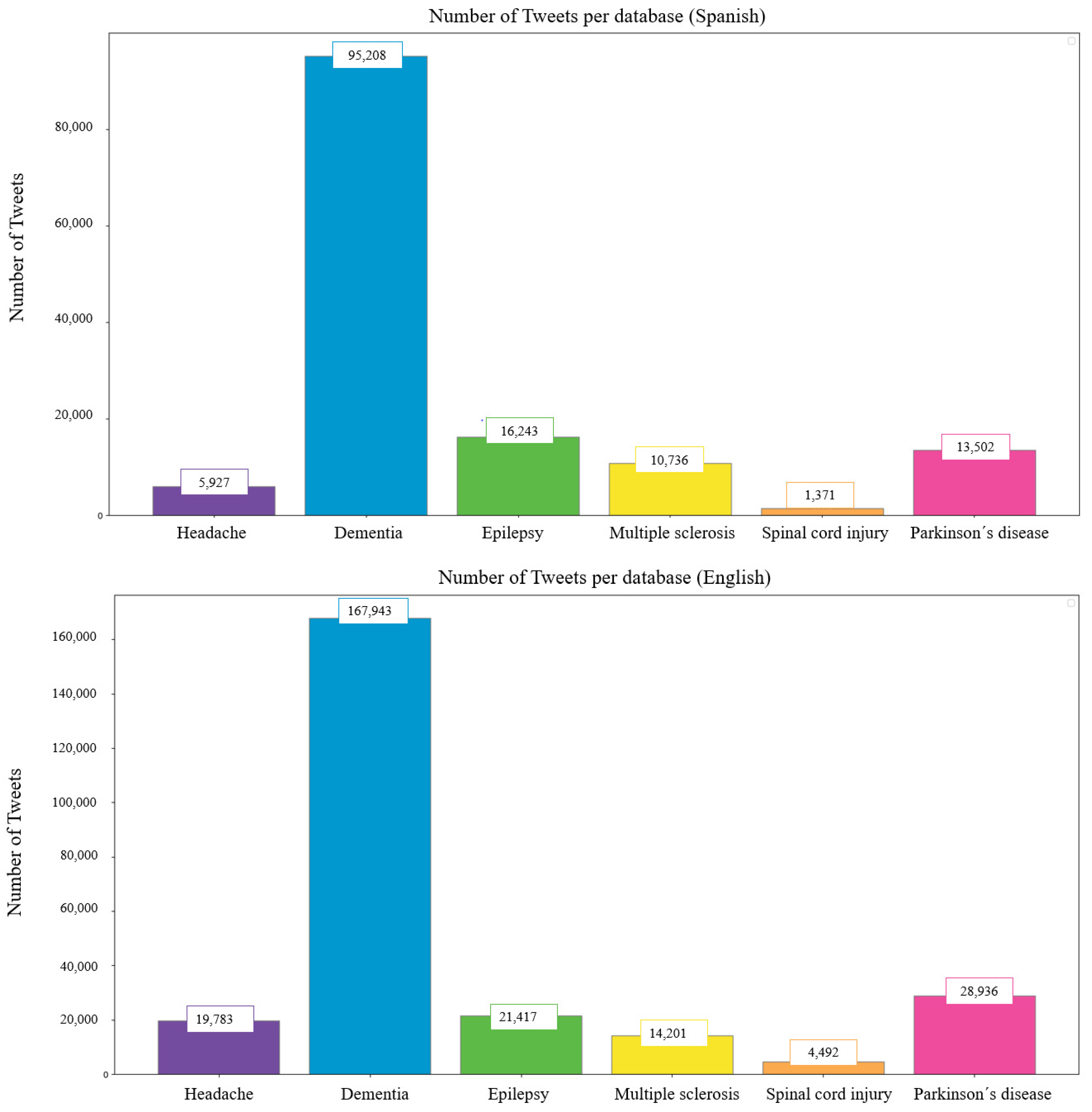
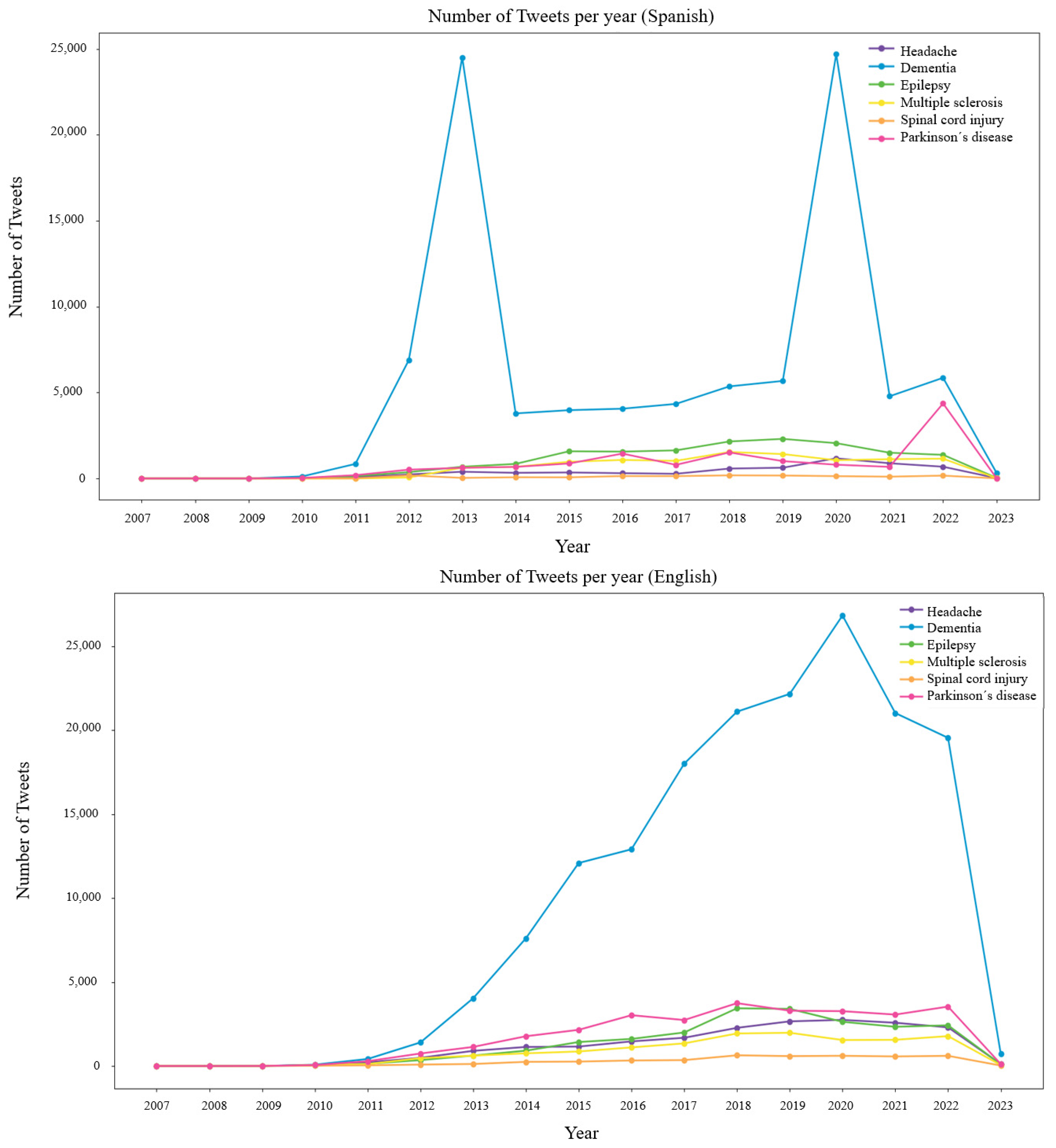
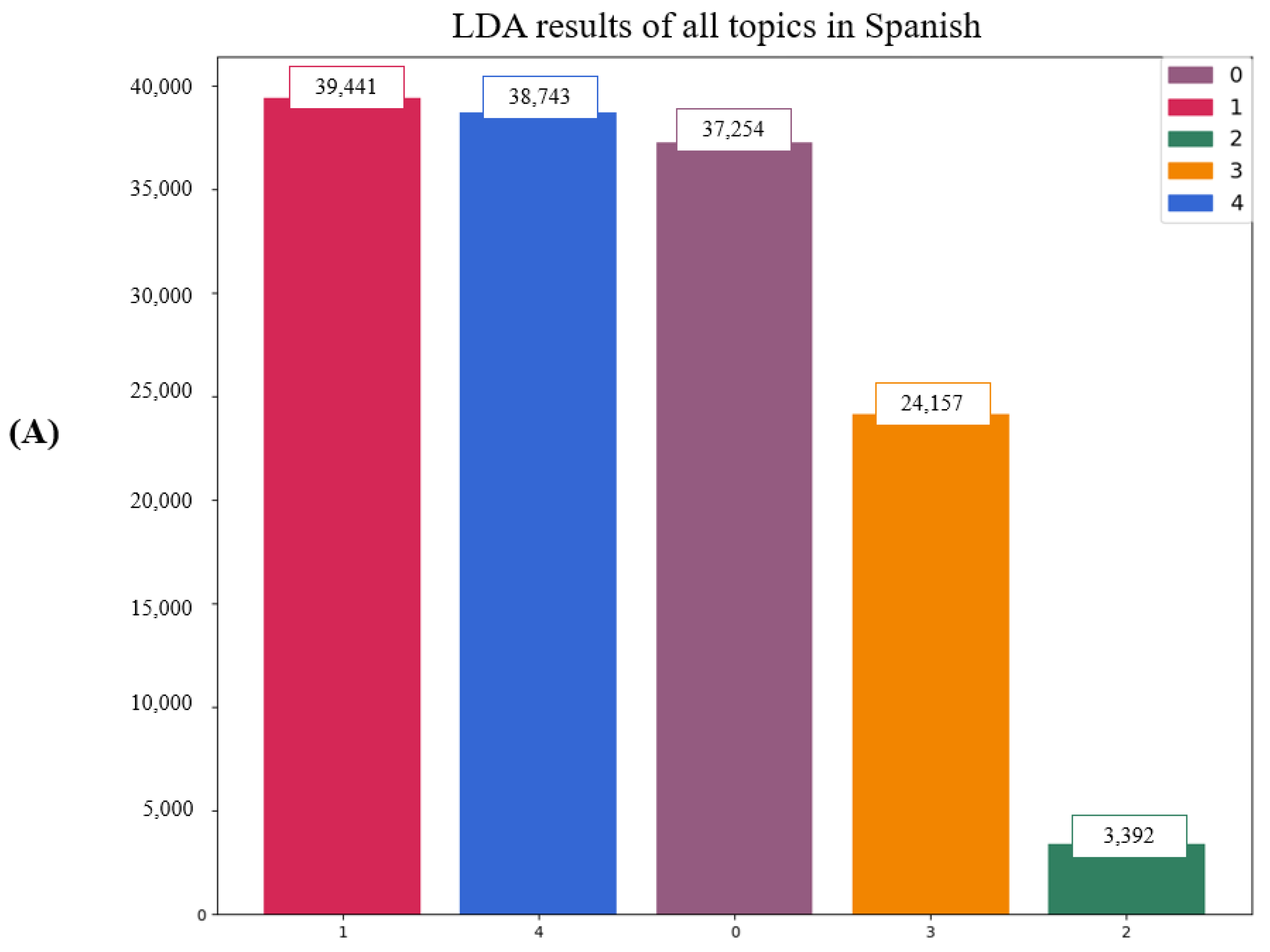
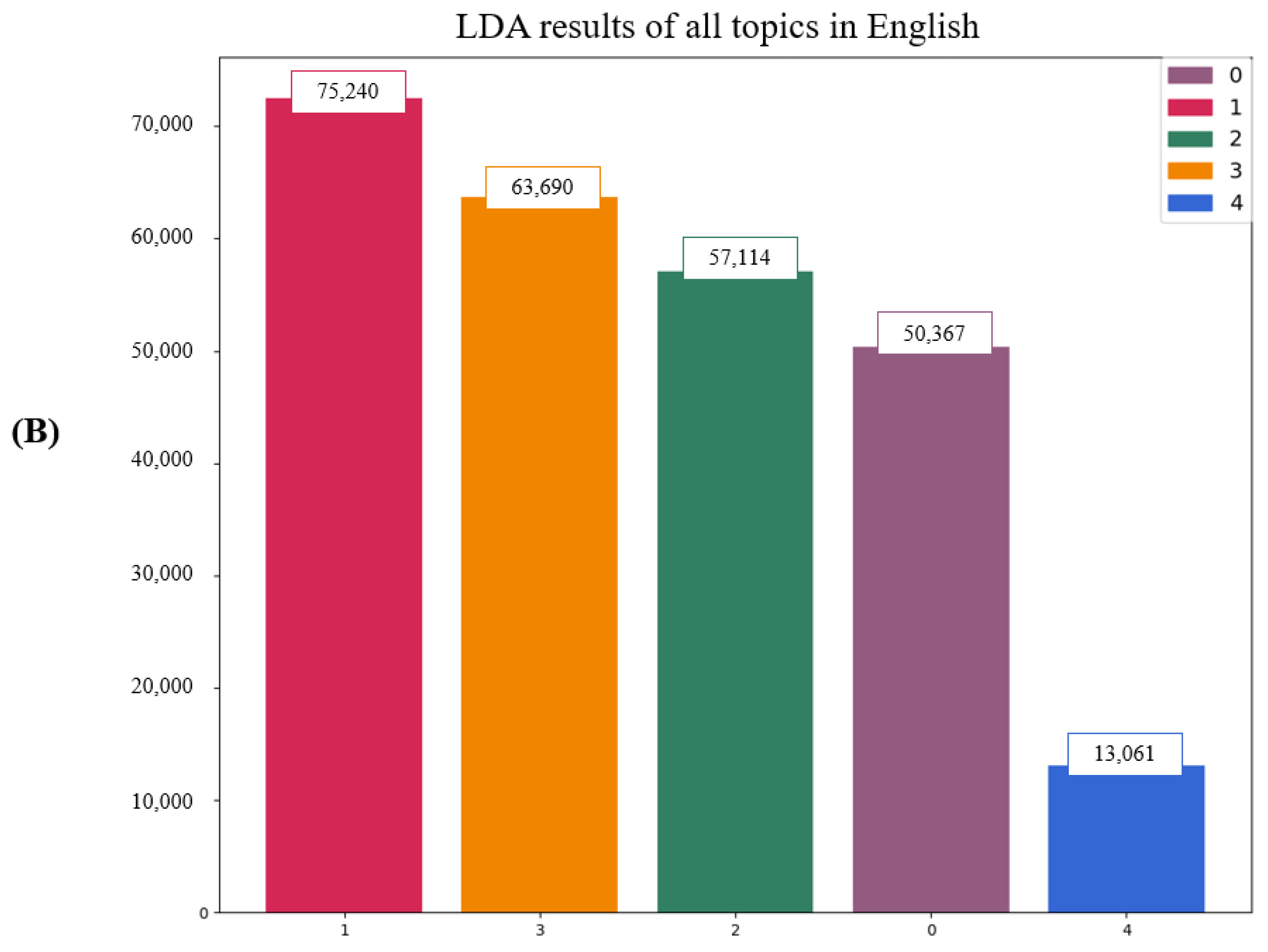
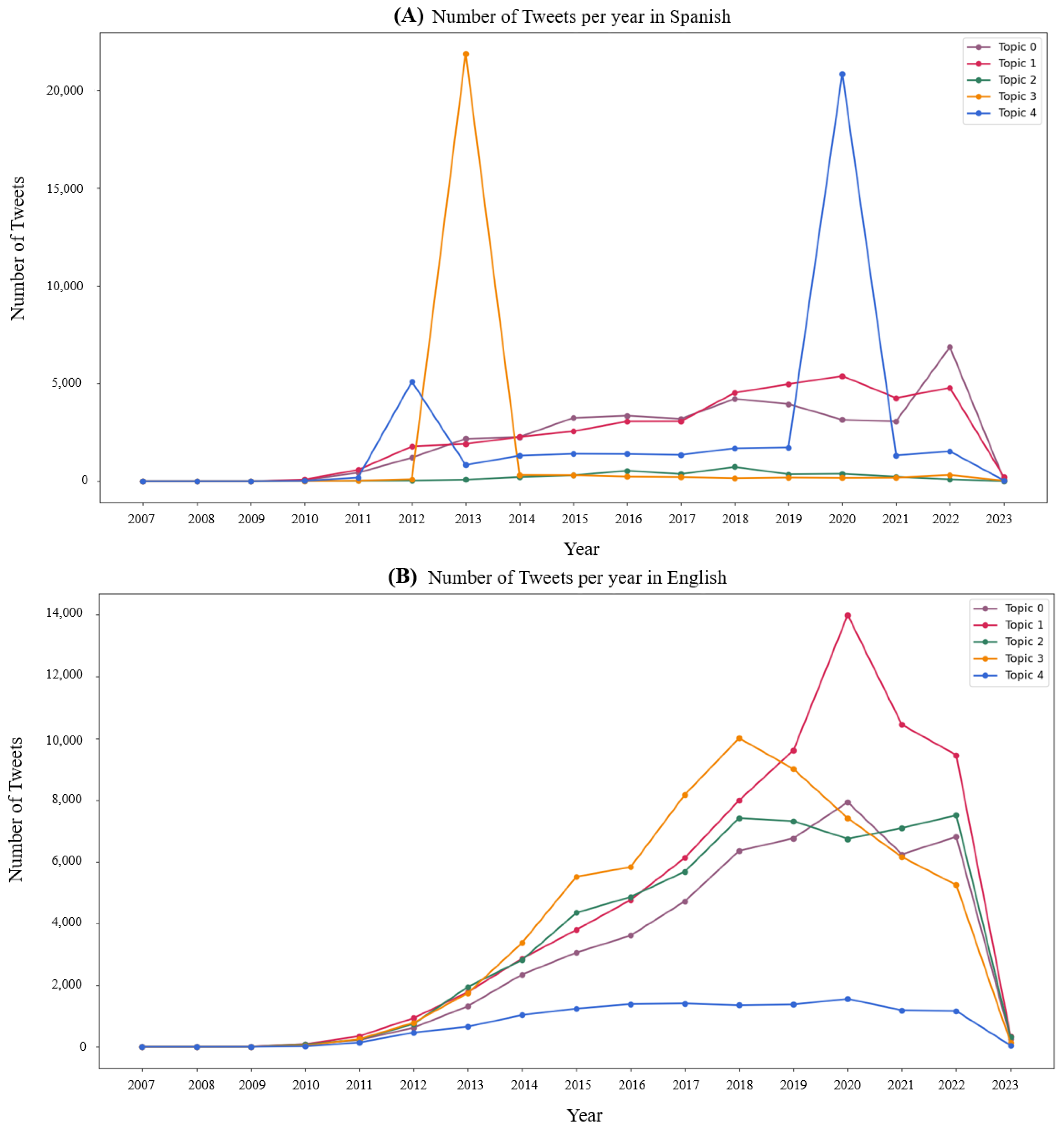
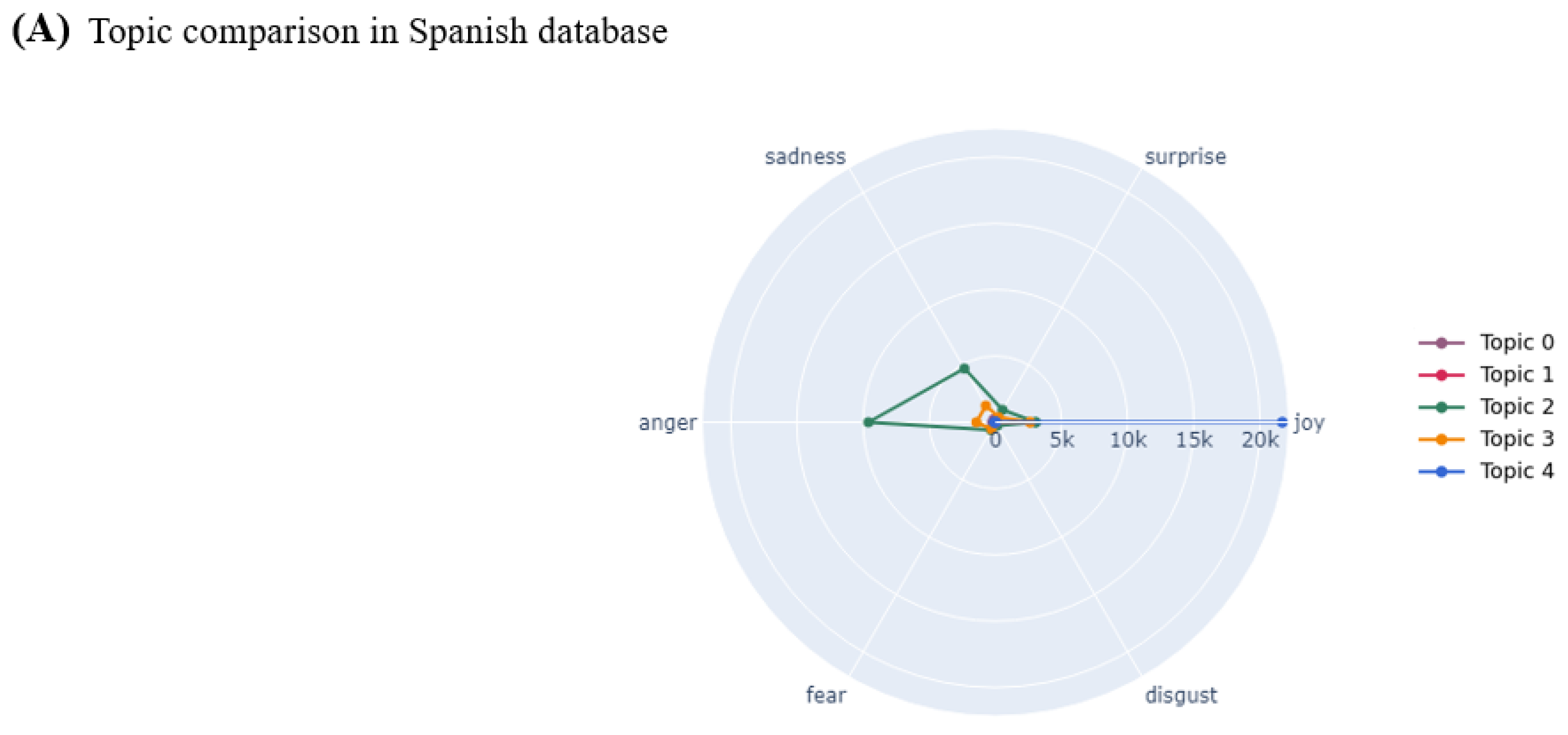
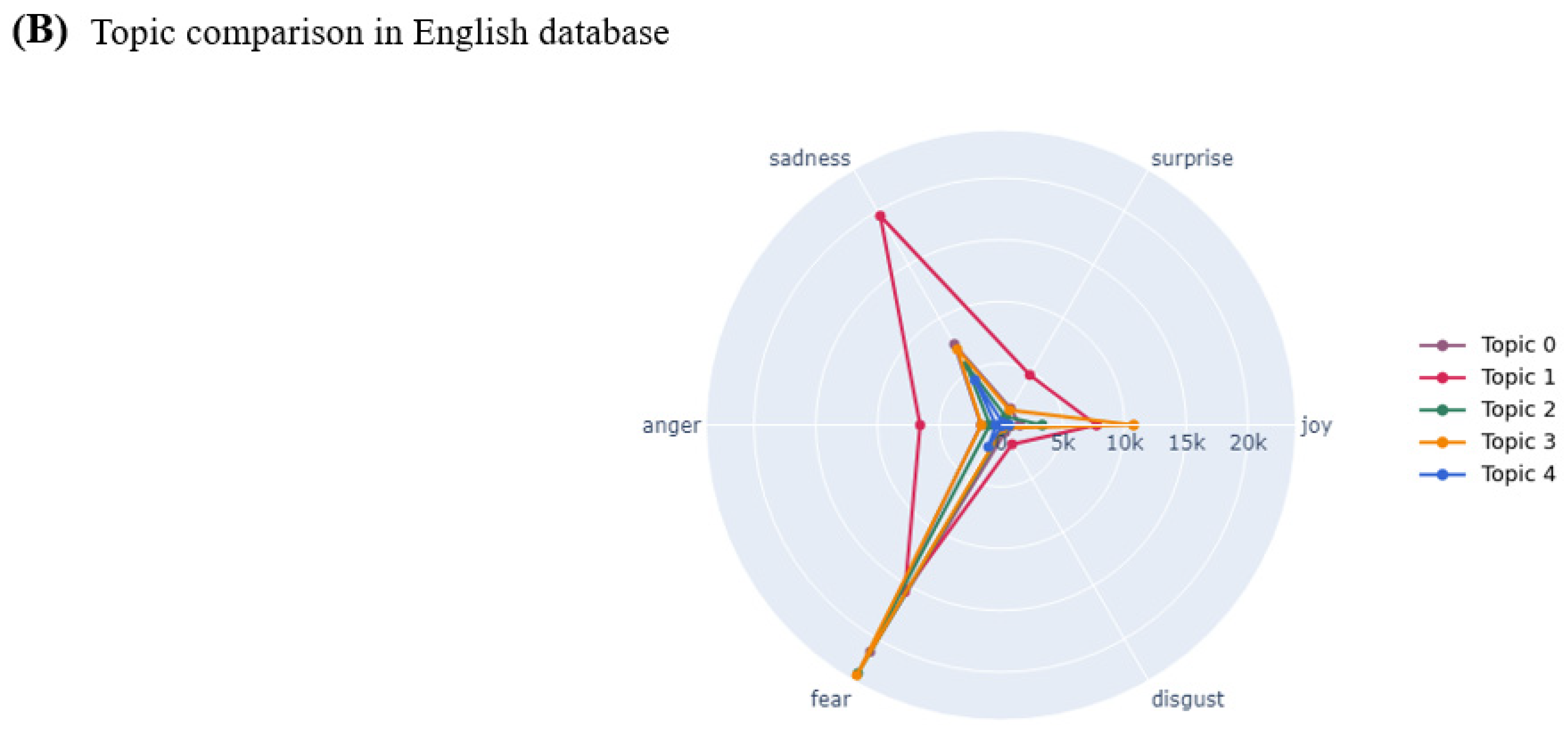
Disclaimer/Publisher’s Note: The statements, opinions and data contained in all publications are solely those of the individual author(s) and contributor(s) and not of MDPI and/or the editor(s). MDPI and/or the editor(s) disclaim responsibility for any injury to people or property resulting from any ideas, methods, instructions or products referred to in the content. |
© 2024 by the authors. Licensee MDPI, Basel, Switzerland. This article is an open access article distributed under the terms and conditions of the Creative Commons Attribution (CC BY) license (https://creativecommons.org/licenses/by/4.0/).
Share and Cite
Domingo-Espiñeira, J.; Fraile-Martínez, O.; Garcia-Montero, C.; Montero, M.; Varaona, A.; Lara-Abelenda, F.J.; Ortega, M.A.; Alvarez-Mon, M.; Alvarez-Mon, M.A. Navigating the Digital Neurolandscape: Analyzing the Social Perception of and Sentiments Regarding Neurological Disorders through Topic Modeling and Unsupervised Research Using Twitter. Information 2024, 15, 152. https://doi.org/10.3390/info15030152
Domingo-Espiñeira J, Fraile-Martínez O, Garcia-Montero C, Montero M, Varaona A, Lara-Abelenda FJ, Ortega MA, Alvarez-Mon M, Alvarez-Mon MA. Navigating the Digital Neurolandscape: Analyzing the Social Perception of and Sentiments Regarding Neurological Disorders through Topic Modeling and Unsupervised Research Using Twitter. Information. 2024; 15(3):152. https://doi.org/10.3390/info15030152
Chicago/Turabian StyleDomingo-Espiñeira, Javier, Oscar Fraile-Martínez, Cielo Garcia-Montero, María Montero, Andrea Varaona, Francisco J. Lara-Abelenda, Miguel A. Ortega, Melchor Alvarez-Mon, and Miguel Angel Alvarez-Mon. 2024. "Navigating the Digital Neurolandscape: Analyzing the Social Perception of and Sentiments Regarding Neurological Disorders through Topic Modeling and Unsupervised Research Using Twitter" Information 15, no. 3: 152. https://doi.org/10.3390/info15030152
APA StyleDomingo-Espiñeira, J., Fraile-Martínez, O., Garcia-Montero, C., Montero, M., Varaona, A., Lara-Abelenda, F. J., Ortega, M. A., Alvarez-Mon, M., & Alvarez-Mon, M. A. (2024). Navigating the Digital Neurolandscape: Analyzing the Social Perception of and Sentiments Regarding Neurological Disorders through Topic Modeling and Unsupervised Research Using Twitter. Information, 15(3), 152. https://doi.org/10.3390/info15030152






